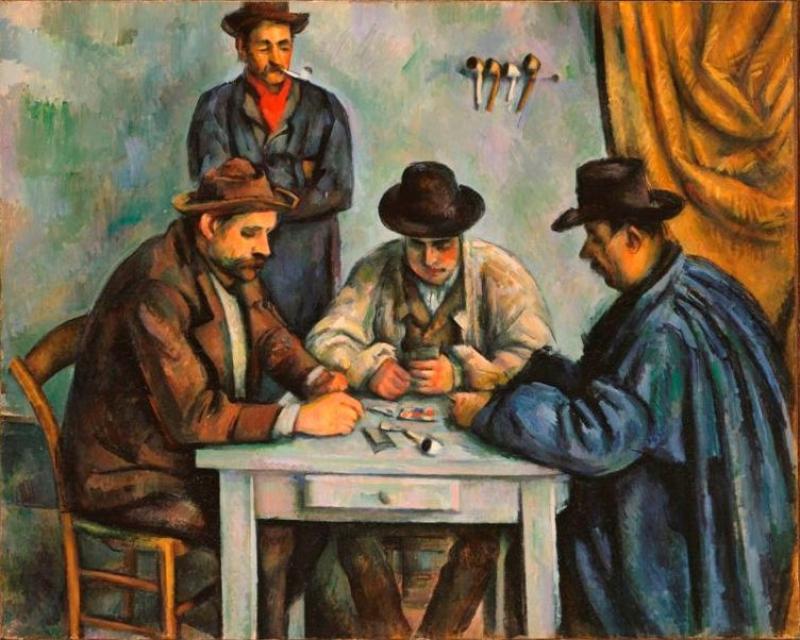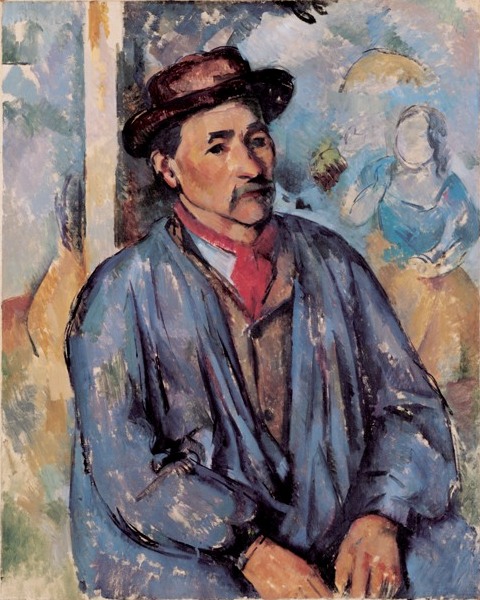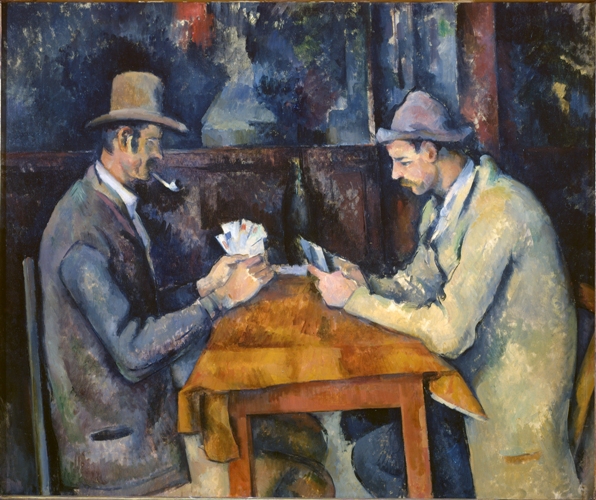Cézanne's Card Players, Courtauld Gallery | reviews, news & interviews
Cézanne's Card Players, Courtauld Gallery
Cézanne's Card Players, Courtauld Gallery
Cézanne's small but monumental series of paintings examined in depth

Give me a small side order of Cézannes over a great feast of Gauguins any day.
This approach, though limited by resources, easily competes with that of the flashiest blockbuster. What’s more, it’s an approach that frequently outdoes the big tub-thumbing surveys. And given the paintings on view in this exhibition, this is certainly the case with Cézanne’s Card Players.
 Along with a few supporting oil, watercolour and pencil sketches, Card Players boasts just a handful of finished paintings. They belong to Cézanne’s series of canvases produced between 1890 and 1896 and dedicated to the depiction of rural farm workers playing cards around a rustic table. It also includes a few of these characters – individuals known to Cézanne as workers on his Provençal estate, Jas de Bouffan - in individual poses (pictured right, Man in a Blue Smock).
Along with a few supporting oil, watercolour and pencil sketches, Card Players boasts just a handful of finished paintings. They belong to Cézanne’s series of canvases produced between 1890 and 1896 and dedicated to the depiction of rural farm workers playing cards around a rustic table. It also includes a few of these characters – individuals known to Cézanne as workers on his Provençal estate, Jas de Bouffan - in individual poses (pictured right, Man in a Blue Smock).
But though you might call Cézanne’s Card Players genre paintings, these are most unlike the animated tavern scenes depicted in 17th-century Dutch and French painting. They are remarkable for their stillness, for their sense of timelessness and simple but imposing monumentality. They certainly epitomise Cezanne’s aim to produce “something solid and endurable, like the art of the museums”.
As such, his peasants are as sturdy and impressive as the aged trunk of an oak tree; so solid and stoically still in appearance that they look as if they might have been carved in wood, their sun-browned features given no more attention to detail or scrutiny than the bottle on the table, or the collar of a shirt. And each part of the painting, regardless of object, is given equal weight, offering a dazzling study of painterly, patchwork surface, but, in the case of the human subject, nothing in the way of psychological penetration. As such, eyes are often as dark and as blank and impenetrable as pebbles. Like the naturalistic novels of his childhood friend Emile Zola, Cézanne was not interested in depicting his sitters as individuals with throbbing, complex inner lives, but as types, responsive only to their immediate environment.
 The first in the series of Card Players – though the exact chronology of the series is, in fact, disputed – is the canvas that is owned by the Metropolitan Museum of Art (main picture). It features four figures, three of which are seated, hunched over their game, with one figure standing, hovering over them in unresolved space. It’s the first painting that confronts you, bang in the middle of the wall facing the gallery entrance. And the thing that strikes you first are the colours, the powdery blue of the backdrop, the tawny gold of a rumpled curtain, the deep blue of a smock and a set of overalls, the latter offset by the fierce red of a scarf. No justice can be done to them in reproduction, but the colours are utterly seductive. What’s more there is little depth of field. And what’s so strange about this painting, when you examine it closely, is that, although the figures all appear so sculpted, so solid, there is little sense of how the hovering figure relates to the seated figures – he appears to have no spatial relationship to the room. Is he backed right against the wall or standing right next to the seated figures? The wall seems to envelop him in a rather ambiguous - though certainly not displeasing - but rather tantalising way.
The first in the series of Card Players – though the exact chronology of the series is, in fact, disputed – is the canvas that is owned by the Metropolitan Museum of Art (main picture). It features four figures, three of which are seated, hunched over their game, with one figure standing, hovering over them in unresolved space. It’s the first painting that confronts you, bang in the middle of the wall facing the gallery entrance. And the thing that strikes you first are the colours, the powdery blue of the backdrop, the tawny gold of a rumpled curtain, the deep blue of a smock and a set of overalls, the latter offset by the fierce red of a scarf. No justice can be done to them in reproduction, but the colours are utterly seductive. What’s more there is little depth of field. And what’s so strange about this painting, when you examine it closely, is that, although the figures all appear so sculpted, so solid, there is little sense of how the hovering figure relates to the seated figures – he appears to have no spatial relationship to the room. Is he backed right against the wall or standing right next to the seated figures? The wall seems to envelop him in a rather ambiguous - though certainly not displeasing - but rather tantalising way.
Whether Cézanne himself saw this as a problem is unclear, but the two later group paintings (pictured above left, the Courtauld-owned Card Players) appear to resolve this ambiguity. Tonality largely replaces colour and two figures are lost, so that we have only two remaining figures, hunched across each other at a table, each lost to the contemplation of their cards. What these paintings lose in colour, they appear to gain in uncluttered architectural monumentality, and to gain further that sense of the timeless that Cézanne strove to achieve. It is not only wonderful to be afforded the space to appreciate each of these great paintings carefully in turn, but to appreciate in such depth Cézanne’s development over this one series.
- Cézanne’s Card Players at the Courtauld Gallery until 16 January, 2011
Share this article
The future of Arts Journalism
You can stop theartsdesk.com closing!
We urgently need financing to survive. Our fundraising drive has thus far raised £33,000 but we need to reach £100,000 or we will be forced to close. Please contribute here: https://gofund.me/c3f6033d
And if you can forward this information to anyone who might assist, we’d be grateful.

Subscribe to theartsdesk.com
Thank you for continuing to read our work on theartsdesk.com. For unlimited access to every article in its entirety, including our archive of more than 15,000 pieces, we're asking for £5 per month or £40 per year. We feel it's a very good deal, and hope you do too.
To take a subscription now simply click here.
And if you're looking for that extra gift for a friend or family member, why not treat them to a theartsdesk.com gift subscription?
more Visual arts
 Help to give theartsdesk a future!
Support our GoFundMe appeal
Help to give theartsdesk a future!
Support our GoFundMe appeal
 Ed Atkins, Tate Britain review - hiding behind computer generated doppelgängers
Emotions too raw to explore
Ed Atkins, Tate Britain review - hiding behind computer generated doppelgängers
Emotions too raw to explore
 Echoes: Stone Circles, Community and Heritage, Stonehenge Visitor Centre review - young photographers explore ancient resonances
The ancient monument opens its first exhibition of new photography
Echoes: Stone Circles, Community and Heritage, Stonehenge Visitor Centre review - young photographers explore ancient resonances
The ancient monument opens its first exhibition of new photography
 Hylozoic/Desires: Salt Cosmologies, Somerset House and The Hedge of Halomancy, Tate Britain review - the power of white powder
A strong message diluted by space and time
Hylozoic/Desires: Salt Cosmologies, Somerset House and The Hedge of Halomancy, Tate Britain review - the power of white powder
A strong message diluted by space and time
 Mickalene Thomas, All About Love, Hayward Gallery review - all that glitters
The shock of the glue: rhinestones to the ready
Mickalene Thomas, All About Love, Hayward Gallery review - all that glitters
The shock of the glue: rhinestones to the ready
 Interview: Polar photographer Sebastian Copeland talks about the dramatic changes in the Arctic
An ominous shift has come with dark patches appearing on the Greenland ice sheet
Interview: Polar photographer Sebastian Copeland talks about the dramatic changes in the Arctic
An ominous shift has come with dark patches appearing on the Greenland ice sheet
 Donald Rodney: Visceral Canker, Whitechapel Gallery review - absence made powerfully present
Illness as a drive to creativity
Donald Rodney: Visceral Canker, Whitechapel Gallery review - absence made powerfully present
Illness as a drive to creativity
 Noah Davis, Barbican review - the ordinary made strangely compelling
A voice from the margins
Noah Davis, Barbican review - the ordinary made strangely compelling
A voice from the margins
 Best of 2024: Visual Arts
A great year for women artists
Best of 2024: Visual Arts
A great year for women artists
 Electric Dreams: Art and Technology Before the Internet, Tate Modern review - an exhaustive and exhausting show
Flashing lights, beeps and buzzes are diverting, but quickly pall
Electric Dreams: Art and Technology Before the Internet, Tate Modern review - an exhaustive and exhausting show
Flashing lights, beeps and buzzes are diverting, but quickly pall
 ARK: United States V by Laurie Anderson, Aviva Studios, Manchester review - a vessel for the thoughts and imaginings of a lifetime
Despite anticipating disaster, this mesmerising voyage is full of hope
ARK: United States V by Laurie Anderson, Aviva Studios, Manchester review - a vessel for the thoughts and imaginings of a lifetime
Despite anticipating disaster, this mesmerising voyage is full of hope

Add comment